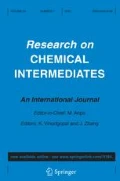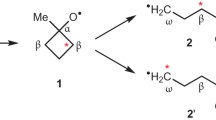Abstract
A simple method is developed to evaluate rate constants from absorbance-time traces for a pair of consecutive reactions consisting of a second order formation and a first order decay of an intermediate. Initially, a first order profile is simulated utilizing the data near the end of the reaction. The difference between this simulated and observed profiles provides the absorbance-time data for the initial phase from which a second order rate constant is evaluated. These rate constants were used to simulate composite kinetic curves which were then compared with experimental curves. This method was used to test the reaction between cis-Pt(NH3)2(H2O)2 2+ and a nonapeptide, ERFKCPCPT. The reaction proceeds through a cysteine coordinated intermediate formed in a second order process (first order with respect to each reactant). The intermediate is then converted to a product through a first order process, in which both cysteines are coordinated to platinum(II).
Similar content being viewed by others
References
J.H. Espenson, Chemical Kinetics and Reaction Mechanisms, McGraw Hill, N.Y., 1981, pp. 65–76.
R. Moore and T.W. Newton, Los Alamos Publication, LA 2347 and addenda.
P.J. Davis and P. Rabinowitz, Methods of Numerical Integration, Academic Press, N.Y., 1984; b) W.C. Gear, Numerical Initial Value Problems in Ordinary Differential Equations, Prentice-Hall, Englewood Cliffs, N.J., 1971; c) A.R. Krommer and C.W. Veberhuber, Numerical Integration on Advanced Computer System, Springer-Verlag, N.Y., 1994.
R.N. Bose, D. Li, and S. Basu, J. Chem. Soc. Chem. Comm., 1731 (1995).
R.N. Bose, S. Moghaddas, and E. Gelerinter, Inorg. Chem. 31, 1987 (1992).
A numerical integration was performed by utilizing a computer program, “KINSIM” kindly provided by Professor Frieden of Washington University, St. Louis, MO.
C. Capellos and B.H.J. Bielski, Kinetic System, Wiley, N.Y., 1972, pp. 96–98.
Author information
Authors and Affiliations
Rights and permissions
About this article
Cite this article
Matuska, N.J., Bose, R.N. A simple method for analysis of consecutive reactions with a second order formation and a first order decay of an intermediate. Res. Chem. Intermed. 23, 109–119 (1997). https://doi.org/10.1163/156856797X00268
Received:
Accepted:
Issue Date:
DOI: https://doi.org/10.1163/156856797X00268




